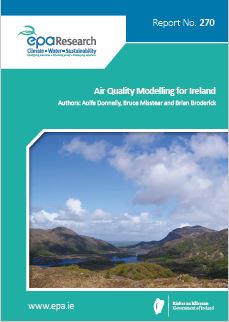Research 270: Air Quality Modelling for Ireland
Authors: Aoife Donnelly, Bruce Misstear and Brian Broderick
Summary: Air pollution is the primary environmental cause of premature death in the EU (EC, 2013) and the most problematic pollutants across Europe have consistently been oxides of nitrogen [e.g. nitrogen dioxide (NO2)], particulate matter (e.g. PM10, PM2.5) and ozone (O3).

Identifying Pressures
Air pollution is the primary environmental cause of premature death in the European Union (EU) and the most problematic pollutants across Europe have consistently been oxides of nitrogen [e.g. nitrogen dioxide (NO2)], particulate matter (PM10, PM2.5) and ozone (O3). Although measurements form an important aspect of air quality assessment, on their own they are unlikely to be sufficient to provide an accurate spatial and temporal description of the pollutant concentrations for exposure assessment. Moreover, they cannot provide information regarding future air quality. Thus, air quality models are an important aspect of air quality management, allowing identification of the concentration gradient and peak location in real-time, forecast and hindcast scenarios.
Informing Policy
Annex XVI of EU Directive 2008/50/EC requires Member States to “ensure that up to date information on ambient concentrations of the pollutants covered” by the Directive are “made available to the public”. This information must include actual or predicted exceedances of alert and information thresholds and a forecast for the following day, of which a model is an integral part. As a result, air quality models are increasingly required for public information, air quality management and research purposes. The primary objectives of this research fellowship were to develop a calibrated air quality forecast model for Ireland capable of predicting the Air Quality Index for Health (AQIH) in each of the air quality zones in Ireland and to model the spatial variation in concentrations on a national scale.
Developing Solutions
This research aimed to determine and quantify current and future air quality so that its impacts can be mitigated through effective solutions. A priority within the Environmental Protection Agency was to produce air quality forecasts based on the AQIH measurements. In order to extrapolate these measurements to the future, statistical modelling was deemed the most suitable. The advantages of this approach were that it could be developed from first principles, it was specific to the area of interest, it avoided any reliance on a third party to supply the model or apply licensing restrictions and it allowed for efficient computation of forecasts. This method was capable of producing accurate pointwise forecasts without the need for a detailed emissions inventory. At the project outset, the emissions inventory was not of sufficient spatial resolution to make realistic point-wise forecasts in all air quality zones by deterministic means and it would have been an inefficient use of resources to base the development of forecasts on what was currently available. This research project has produced a forecast model for predicting NO2, PM10, PM2.5, O3 and sulfur dioxide (SO2), 48 hours in advance, at key monitoring locations across Ireland. The model was validated, and the results are available in a separate model validation report.
In conjunction with a second research project (2013-EH-FS-7), a set of annual mean maps within a geographic information system (GIS) environment was created and validated for each of NO2, PM10, PM2.5, O3 and SO2. These provide a highly relevant source of information regarding spatial variation in concentration levels on a national scale that can be used not only for exposure studies and general air quality assessment, but also as a tool to correlate emission sources and surrogates with air quality.
The stepwise approach chosen for model development allowed deliverables prior to completion of the project while minimising associated risks. The models developed as part of this fellowship form solid building blocks on which future air quality modelling studies in Ireland can be based.
https://www.epa.ie/media/epa-2020/publications/research/Research_270_Air-quality-modelling-for-Ireland.jpg